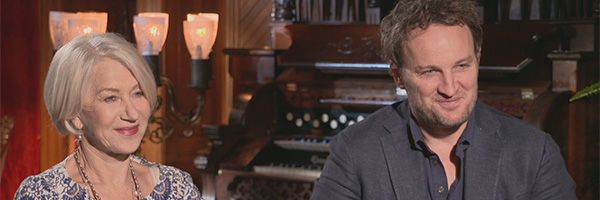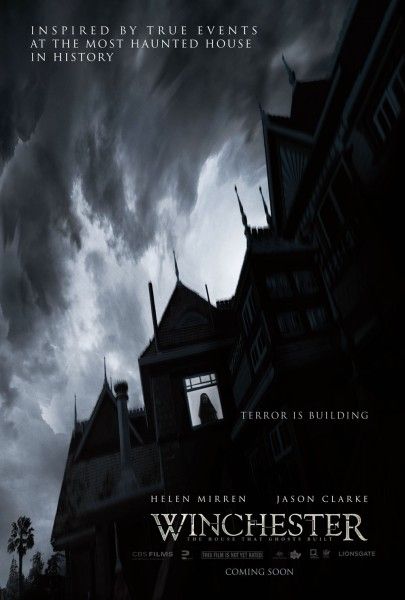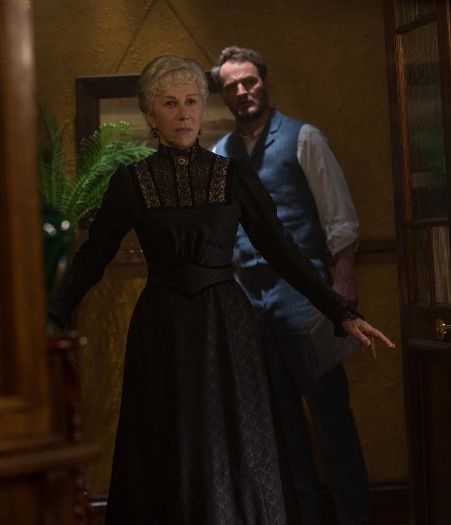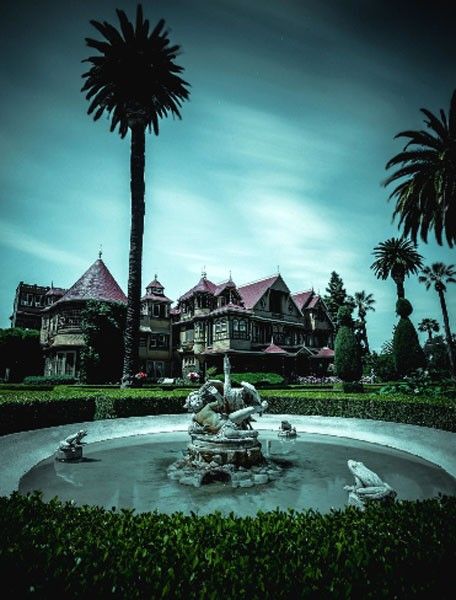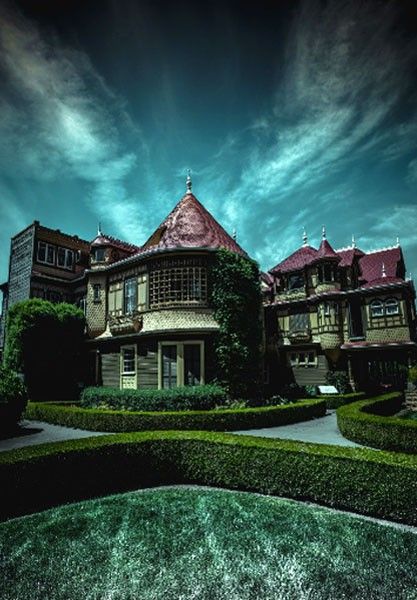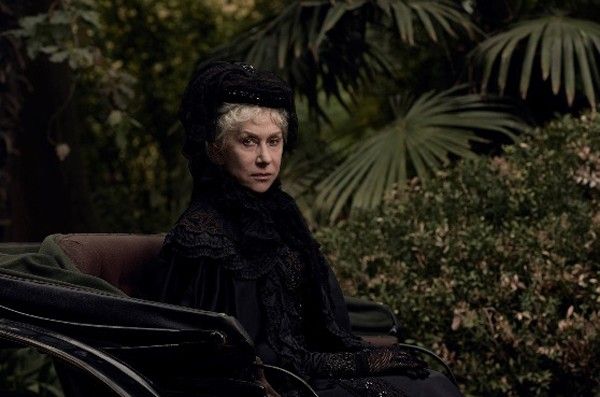-
On May 5, 2017, Collider was invited out to the Winchester Mystery House in San Jose, Calif. for a few hours, on behalf of CBS Films’ upcoming release Winchester: The House That Ghosts Built (in theaters on February 2, 2018), to get a private tour of the massive labyrinth-like mansion that’s considered the most haunted house in the world and to learn a bit about the upcoming feature film. Having never had the opportunity to see the house in anything other than photographs, I wondered what it would be like to explore and what the vibe might feel like, and I left feeling like every oddly shaped room, each hallway with a low ceiling and the endless staircases, all added up to a fascinating story about a woman who will forever remain a mystery herself.
Inspired by true events, the story of the film follows Sarah Winchester (played by Academy Award winner Helen Mirren), heiress to the Winchester fortune, which included $20 million and the equivalent of $25,000 per day for the remainder of her life, and was amassed from the manufacturing of the repeating rifle that was acclaimed for both its speed and accuracy. After the sudden deaths of her husband and child, Sarah Winchester used that money to keep construction of the house going, 24 hours a day, seven days a week for decades, until it stood seven stories tall with hundreds of rooms, some of which had stairways to nowhere and doors that opened into the courtyard, with quite a drop to the ground below. From the outside, all of the building looked like the manifestation of a disturbed woman’s madness, but Sarah believed that she was working to imprison the hundreds of vengeful ghosts who were affected by the Winchester rifle.
Along with touring the house, Collider was able to participate in an on-camera interview with Helen Mirren and Jason Clarke (who plays Eric Price, the brilliant psychiatrist summoned to the house by Sarah Winchester) inside of the ballroom, and a small press conference with the co-stars and their directors, brothers Peter and Michael Spierig. On video (which you can watch above), Mirren and Clarke talked about first impressions of Sarah Winchester, why Eric Price is drawn to her, and what it’s like to be in the real house, as opposed to the recreation they worked in on a set in Australia. During the conference, the actors and filmmakers further discussed what they shot in the actual house, the need for recreating the house on set, the research they did, what makes Sarah Winchester such a compelling character, and the genre the film falls under.
Question: Have you been to the Winchester House before?
HELEN MIRREN: It’s my first time here. I’ve never been here before, and I’ve been blown away by it. It’s amazing!
Peter and Michael, what are you actually filming in the house?
PETER SPIERIG: We’re here at the real house to shoot elements of the real rooms – the real ballroom, certain bedrooms and hallways. There’s also quite a lot of aerial stuff we’re doing, flying over the house with drones. It’s a combination of cutting what we’ve built in Australia and the real house, as well.
There’s not exactly a lot of room to shoot inside the house itself.
PETER: It’s complicated, yeah. Getting gear upstairs is pretty tricky.
MICHAEL SPIERIG: This house is so amazing. The rooftops are so extraordinary that we’ve shot a lot of the rooftop here. The interesting thing is that we’re recreating the house in 1906, and San Jose was quite different in 1906. There were a lot of orchard fields. It was pretty open farmland. Now, there’s hotels and Winchester Blvd., and it doesn’t look like it did in 1906. We shot aerial units, but there’s a lot of visual effects work to do to bring it back to the period of 1906.
Is it eerie to be in the real house, after shooting in a recreation of it?
MIRREN: Eerie is not the right word. It’s inspiring and moving and fascinating. I haven’t actually shot any of my scenes here. I finished in Australia, a few weeks ago, but it’s been fantastic for me to be in this house. It was immaculately reproduced in Australia. In Melbourne, in this very era, there was a wave of enormous wealth that came in and architecturally there was a lot of building in Melbourne, in the European style of building, at that time. There is a connection there. We shot in a couple of big houses, of this era, in Melbourne, but to be in the real house has been a really amazing experience for me, actually.
MICHAEL: We’re set in 1906, and there was non-stop construction for 40 years. We’ve shot a lot of the actual rooms here, but it’s hard to determine exactly what existed, in that period. There are some photographic references, but she would build rooms and tear them down, almost instantly, so it’s very hard to know exactly what was there, in that period. That’s been fascinating.
This house has its own history to it. Did you go anywhere else for background and research?
MICHAEL: There are several books on Sarah Winchester that are quite interesting, and we certainly used them as research material. One, in particular, was a book called Captive of the Labyrinth, which was an interesting, well-researched book on the history of Sarah Winchester, growing up in New Haven and meeting William, her husband. There were stories about all of the Winchesters and about how the family progressed, through the years, and that was helpful. And there are books on the Winchester rifle and the development of that weapon. There’s not that much about Sarah Winchester out there, but some people have done some pretty extensive research, here in San Jose, on her. She was a very private woman.
What did you do to get into Sarah Winchester’s head?
MIRREN: Sarah is an incredible gift for an actress. It’s very similar to playing the Queen. There is so much known about her, and yet, at the very center of all that knowledge, is this character of utter mystery, and Sarah is very similar. As an actress, you’re allowed to have your own understanding and feeling of what this person is, but there is a lot of research material. There are photographs of her, and we have this amazing house. Imagine if this house didn’t exist and we had to imagine what it was like. We don’t. We can sit in it and see it and feel it, and you do feel something when you’re here. You feel the personality and the character of the person that created it. So, it was a real gift, as an actress. Obviously, we have to be true to the script. That’s a further influence on what you’re doing. The most important influence is what’s described in the script.
Is there anything that you’ve learned, since you’ve been in the actual house, that you wish you’d known before you started filming?
MIRREN: No. I had a lot of research material and our two directors, before we’d even started. They created a beautiful look book with a lot of visual information in it, and we also had an amazing cinematographer. Our production designer made the sets immaculate, and then it was extraordinarily well-lit by our cinematographer. We had a great advantage, in the sense of recreating the atmosphere of the house to work in.
Did you have to scale the set up, so that you could work more comfortably, since some of the ceilings in the real house are so low?
PETER: No, we recreated certain rooms almost exactly to scale. In fact, there’s a sequence in the switchback staircase, which we knew logistically was going to be interesting. We might have made it a couple centimeters wider, but it was a very tricky thing to shoot. We tried to keep it pretty accurate. Part of the charm of this house is that you go into a mansion thinking it will have big, open spaces, but that’s not the case. A lot of it is quite tiny and there’s a sense of claustrophobia in such a big place.
MIRREN: Alice in Wonderland is a perfect description of this house. It has that Tim Burton-ish, Alice in Wonderland-ish feeling when you walk in. Within a minute of being in the house, it’s down the rabbit hole. You’re in this world and, suddenly, your whole world is different proportions, different colors and a different sense of light. There’s a lot of light, and yet, somehow, it’s also shadowed. It’s an amazing environment to be in.
MICHAEL: I’ve been in this house so many times, and I still get lost, every time.
PETER: It’s funny bringing a film crew in here because every department needs a guide. If you move, you have to stick with your guide to get to the next room.
What was it that made you want to tell this story?
PETER: It was the story of Sarah Winchester. It was the story of a woman who inherited this great fortune, but also felt a tremendous amount of guilt because she was ultimately haunted by the people that died at the hand of the rifle. That, alone, was a fascinating story. And then, the fact that she built this house, on top of all that, was super exciting.
MIRREN: For me, it was the character of Sarah – the mystery of it, the complication of it, the emotion of it, the passion of it and the fact that it was true. Obviously, we are making a movie, and a certain kind of movie, but there’s a core of absolute truth in it. This actually happened.
In your portrayal of Sarah, how did you bring together the fact that she was innovative and smart with the fact that she was so superstitious and caught up in the supernatural?
MIRREN: I don’t know if she was superstitious. All I could think of was how she felt, whether it was guilt or empathy with the families of the people who had died by this very thing that had made her family very rich and made her very rich. It was clearly an absolute love match, and then she lost her young husband and child, very quickly together, and had the trauma of that. It’s been amazing. We had the set and it was beautiful, but I didn’t fully understand the absolute scale of the achievement, of the decoration, and of the attention to detail. That requires a certain kind of person. It’s a very special kind of person that has that kind of attention to detail. So, I don’t see her as a person driven by superstition, at all.
MICHAEL: In that period, women weren’t architects. She had all of this money and she had the opportunity to build, non-stop for 38 years. She got to explore her passion.
MIRREN: I think she was a builder, rather than an architect. The closest thing I’ve been thinking of is Watts Towers, where you have a physical manifestation of the design sensibility and the artistic need to build something that’s physical and out there, in the open air. It’s not a poem or a book. It’s something physical that’s designed and solid. Ultimately, it’s an artistic expression.
MICHAEL: She was also very inventive. If you look at this house, she was ahead of her time with a lot of the things that were in here, like the intercom systems. She was one of the first people, I believe, that had a telephone and a shower. She was a pioneer, on those levels. She was a very forward-thinking person.
Do you believe in the supernatural?
MIRREN: No, I don’t, but I do believe in the power of belief. It’s a human condition that we have, the power of the imagination. I think human beings are driven, really, by their imaginations, above all, and the power of that is endless. So, I do believe in that. I don’t personally believe in the supernatural, but I understand when people do and they are so utterly convinced. There’s so much that one can believe in, if one wants to.
What genre does this film fall into?
PETER: It’s a thriller with supernatural elements in it.
Are there any movies that you referred to, as influences?
PETER: Maybe The Others is an example, but I’d like to think it’s its own thing. It’s got lots of scary stuff in there, but it’s also a story about two people who ultimately have to collide together, in order to overcome something.
Jason, was your character a real person?
JASON CLARKE: No, he’s a made-up character that comes in to assess Sarah. It works on a narrative guide level, and also on an overall subplot level of believing or not believing. He’s a guest in the house, there to assess her mental state.
Are there any secondary characters in this story?
PETER: There are other characters. Sarah Snook, an Australian actress who we worked with on our last movie, plays Sarah Winchester’s niece, who was a real person, too. And then, we have the foreman, played by Angus Sampson, who was also a real person. We’ve taken real people and worked them into the story, as well.
Did you guys do your own action sequences?
MIRREN: I wouldn’t call them action sequences. They called and said, “Can you do your own action?” I said, “What is it?” They said, “You have to kneel down.” Yes! They said, “Do you want us to get a stunt girl to do the kneeling for you?” I said, “I can kneel.” That stuff is the fun stuff. The great thing that our directors wanted was to make it as real as possible. Obviously, they have to use digital effects to recreate the house, as it used to be, but in terms of what happens within the house and in the dramatic scenes, it was as real and present as possible. There was a certain amount of old school movie magic, which is so fun to be a part of.
What was it like to shoot the earthquake scene?
CLARKE: It hurt!
MIRREN: It was very dirty.
CLARKE: You just have to jump around and have things fall on you. That’s basically it. You have to keep throwing yourself against a hardwood floor.
Being so private, how does Sarah Winchester feel about having someone show up to evaluate her mental state?
MIRREN: Well, you’ll see in the movie. There is a reason that she needs him, as much as he needs to be there. She needs him in the house, and there is a special, rather brilliant plot device that Michael and Peter have invented. She has almost a greater need for him to be there, as he has a reason to be there. She chooses him, in a way, to come to the house.
Winchester: The House that Ghosts Built opens in theaters on February 2, 2018.

